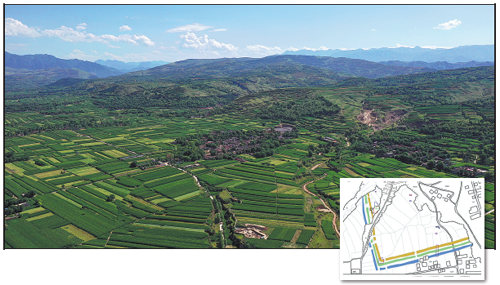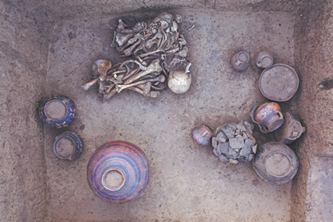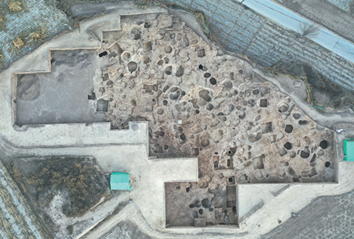Discovery of large-scale settlement at Siwa site, in Gansu province, provides intriguing evidence of advanced society, Wang Ru and Wang Kaihao report.

When Italian President Sergio Mattarella had his state visit to China in November, he was invited by President Xi Jinping to appreciate some precious Chinese cultural relics that were put on display at the Great Hall of the People in Beijing.
These artifacts, which were illegally exported and seized in Italy, were returned from the European country to China in a gesture of international cooperation on cultural heritage protection. Eight painted pottery vessels were the highlights on that occasion. Their origins were traced to the Majiayao culture, a Neolithic archaeological culture in the upper reaches of the Yellow River dating back 4,000 to 5,000 years.
Widely believed to be a peak of prehistoric painted pottery art, the culture is marked by various pottery types decorated with intricate and exquisite patterns. Majiayao culture was first discovered in 1924. Even aft er a century of research, people still only had a rough understanding of its time and scope. Without evidence of any large-scale settlement, researchers did not know much about its residential form, or means of livelihood and social structure. This major stride was filled by archaeological efforts on the Siwa site in Lintao county, Northwest China’s Gansu province from 2018 to 2024.
Located in the transitional zone between the Loess Plateau and the Qinghai-Tibet Plateau, the site is on a flat platform in front of the Jiulong Mountain, with the Taohe River, a branch of the Yellow River in its upper reaches, flowing by.
Guo Zhiwei, a researcher at the Institute of Archaeology, Chinese Academy of Social Sciences, leads the archaeological team at Siwa. He says they discovered a high-level, probably central settlement of Majiayao culture in the north of the site. Inside the settlement there is a triple-layered moat system, nearly 100 residential foundations, many crypts and pits where ancient people dumped garbage and several tombs, spanning the early and middle stages of Majiayao culture.

Archaeologists had long hoped to find the central settlement of Majiayao culture in nearby sites but failed. “Finally, our dream comes true, marking a significant step to further unveil the culture,” Guo says.
To their delight, they found an intricate moat system from the settlement, which has three layers parallel with each other. They encircle a nearly square area covering almost 300,000 square meters. All are 8 to 9 meters away from each other, having a width of 9 to 10 meters.
After excavations on the three moats, archaeologists found the inner one has obvious differences from the other two, since it has much richer remaining evidence of habitation, including house foundations, pits and pottery kilns. The number of animal bones unearthed from this moat is also much more than the other two.
“Considering their time, layout and unearthed relics, we believe the three moats probably existed and functioned during the same time, but were different in their usage. The outer two were for defense and water drainage, but the inner one was a ditch-like production and living area,” says Guo.
ALSO READ: A tribute to craftsmanship
“The moat system was a major project accomplished after careful plan and measurement. It was mainly used during the early stage of Majiayao culture, about 5,000 years ago as the country’s earliest known multi-rectangular moat structure and may be a prototype of oblong (or square) cities (that appeared often in later dynasties).”
In the area encircled by the moats, they found multiple pottery-making areas and kilns and a large number of tools and semi-manufactured vessels. Moreover, stone-artifact processing workshops and sets of stone semi-manufactured goods were also found.
“Because pottery-making was of a large scale and spanned several hundred years, the artifacts show advanced skills, and the Taohe River Basin has been known as an area with the best painted pottery-making techniques, we believe the settlement was probably a regional pottery production center,” says Guo.
Plant remains and animal bone analyses show ancient people at the site had millet and raised livestock, but the animal husbandry was not very mature. Based on the findings, Guo says with limited agricultural resources and immature animal husbandry, handicraft production may have played a major role in the economy of Majiayao society, also driving it to a high level of development.

Focusing on the key period from 4,000 to 5,000 years ago in tracing the origins of Chinese civilization, archaeologists have made key discoveries in the lower and middle reaches of the Yangtze River and lower reaches of the Yellow River.
But the situation on the upper reaches of the Yellow River long remained unclear. As the Majiayao culture mainly spread in this region and was from that period, it may fill in that blank, Guo says.
Previous findings in the Neolithic sites of eastern area of China showed that they had rich agricultural resources, a strong religious atmosphere and obvious differences in social status.
“Compared to them, in the upper reaches of the Yellow River, ancient people also had agriculture as the basis, but paid more attention to handicrafts and trade. They didn’t have that strong religious atmosphere, nor obvious social or wealth differentiation, but civilization here also developed to a high level,” says Guo.
Majiayao culture has been known as an extension of the Yangshao culture, a key Neolithic culture dating back 4,600 to 7,000 years across the northern part of China, as the result of its northwestern spread. Majiayao continued to extend its influence to various directions including the Qinghai-Tibet Plateau and Sichuan Basin. Very similar painted pottery vessels have been found from Qujialing site in the middle reaches of the Yangtze River and Jiaojia site in East China’s Shandong province.
“Going northwest, it could enter the Hexi Corridor (the main artery of the ancient Silk Road in Gansu) and communicate with culture from Central and West Asia. Therefore, during prehistoric times, the area Majiayao culture located was at the forefront of early civilizational communication,” he adds.

Similar pottery vessels have also been found from West and Central Asian sites, urging archaeologists to consider if there was an ancient “painted pottery road” that was a predecessor of the ancient Silk Road linking people on the Eurasian continent through pottery trade. “Majiayao culture was among the earliest to engage in cultural exchanges with Central Asia and other regions,” says Han Jian ye, an archaeology professor at Renmin University of China in Beijing.
He says: “We can say the development and growth of it laid the cultural foundation for China’s western frontier area in the prehistoric era, paving the way for early cultural exchanges between the East and the West through the ‘painted pottery road’. Therefore, Majiayao culture occupies a significant historical position in the early development of Chinese civilization.”
Another highlight from recent studies is the find of a large-scale settlement from the middle period of the Majiayao culture, described by archaeologists as Banshan type.
READ MORE: Breakthrough findings span from Paleolithic period to Qing Dynasty
Researchers had rarely discovered residential foundations of the Banshan type except for findings made by late archaeologist Yan Wenming in 1963 in Lanzhou, the provincial capital of Gansu. The newly-discovered Banshan settlement is expected to provide more materials for cultural communication, especially the introduction of metallurgy, sheep, cattle, barley and wheat to China.
Guo says these are widely believed to have originated from West Asia. From sites of early stage of the Qijia culture, a Neolithic culture in the upper reaches of the Yellow River — with its earliest period approximately contemporaneous with the late period of Majiayao culture — a large amount of such “exotica” has been discovered. Therefore, archaeologists guess during the middle Majiayao cultural period, such things may also be found, shedding light on their early travel to China.
“The latest discoveries demonstrate Siwa site was a large central settlement site of the Majiayao culture. ... They tell us the developed painted pottery handicraft, foreign trade and exchanges were probably key reasons why Majiayao culture could spread to and influence so many areas,” Han says.
Contact the writers at wangru1@chinadaily.com.cn


